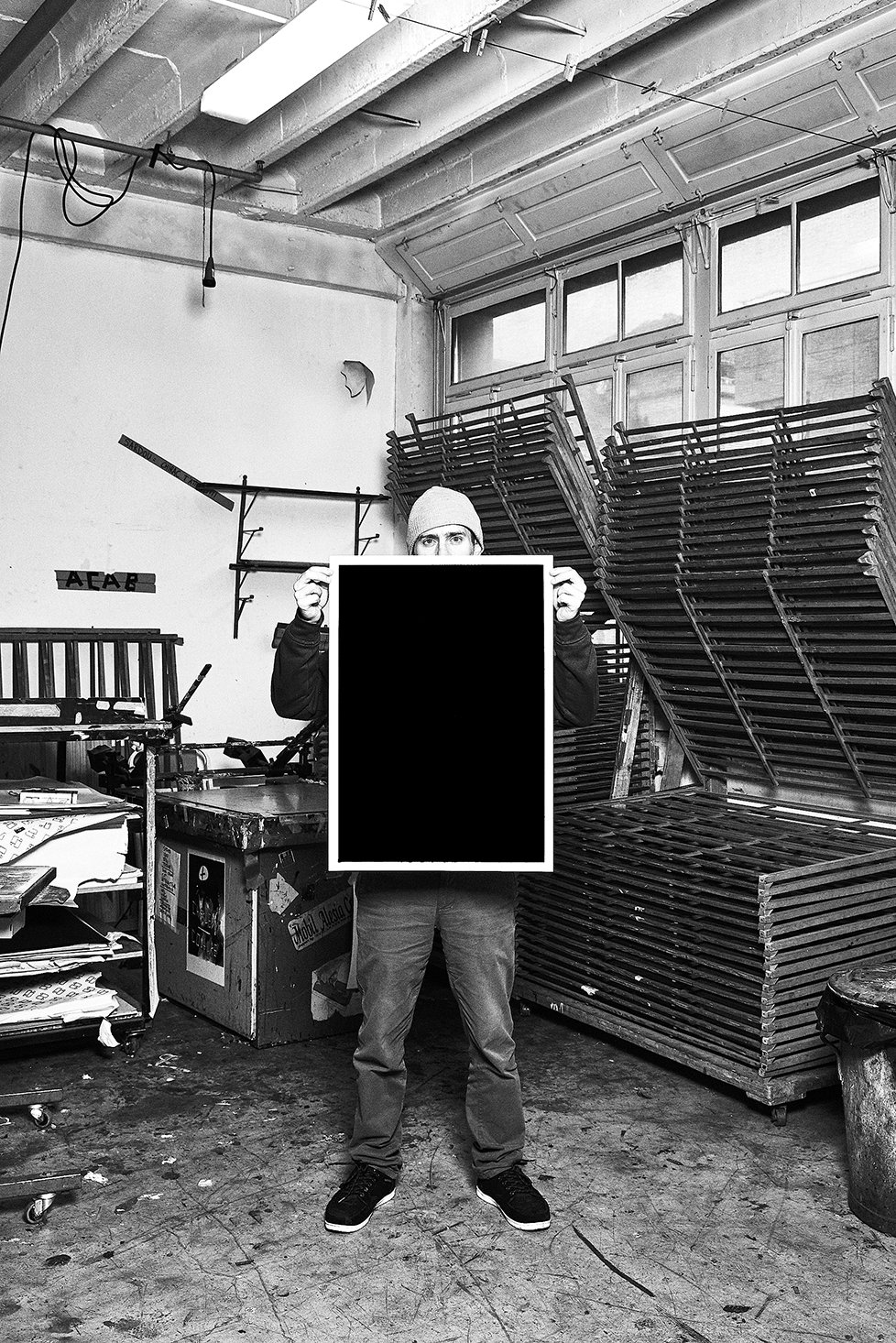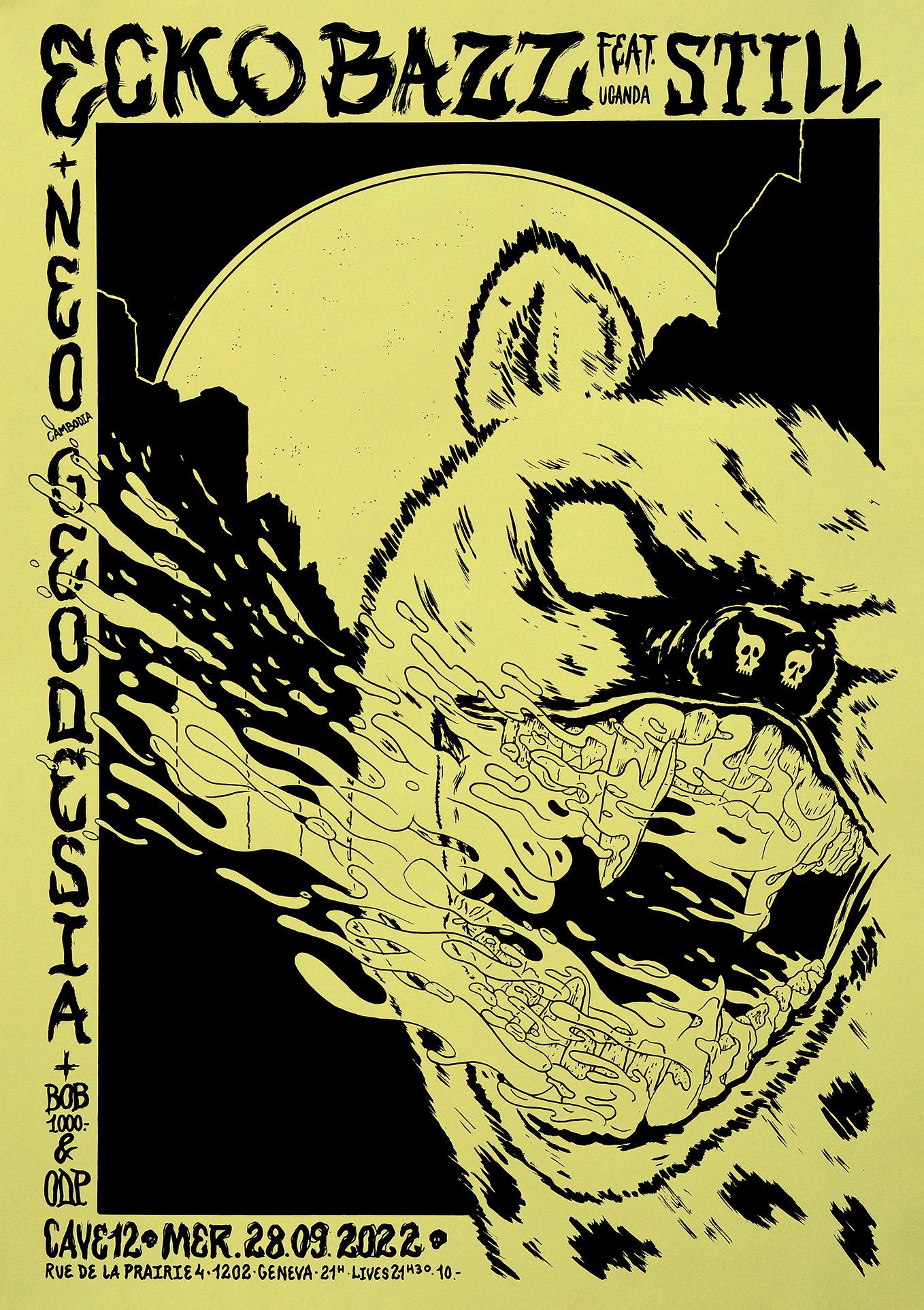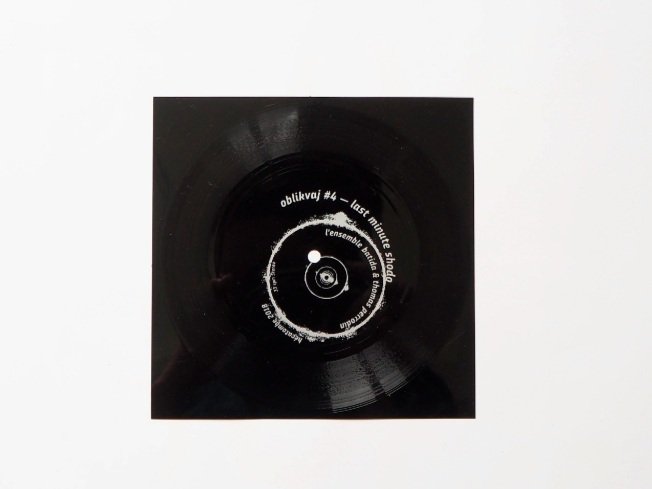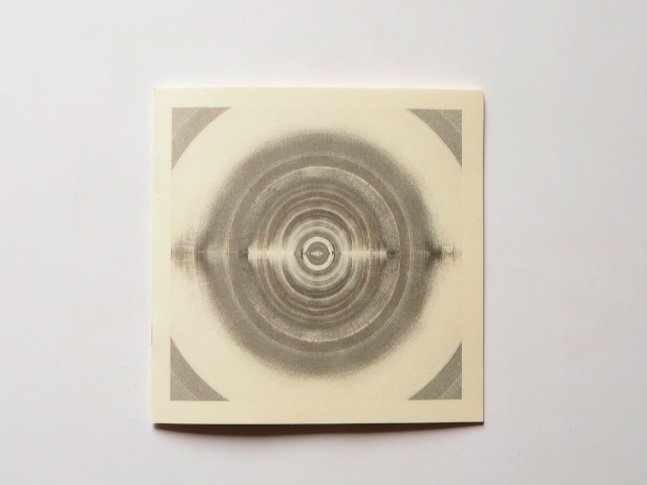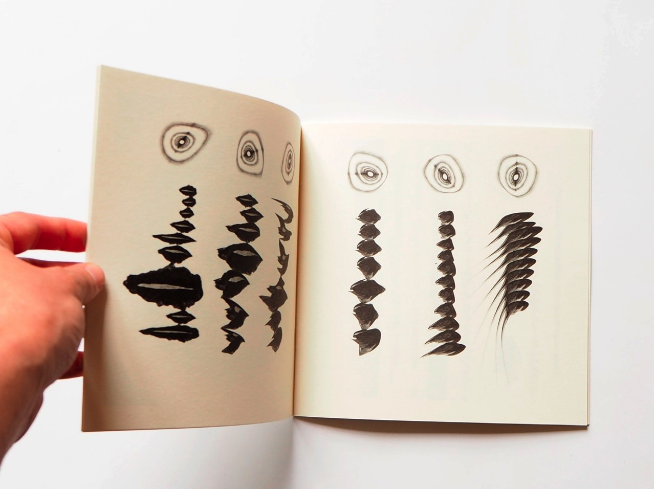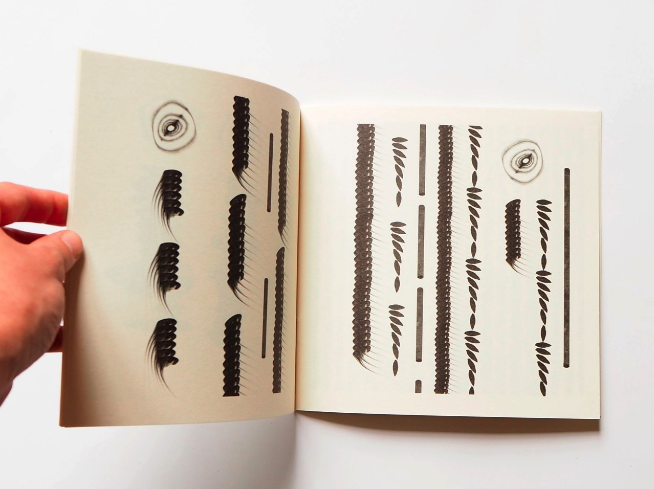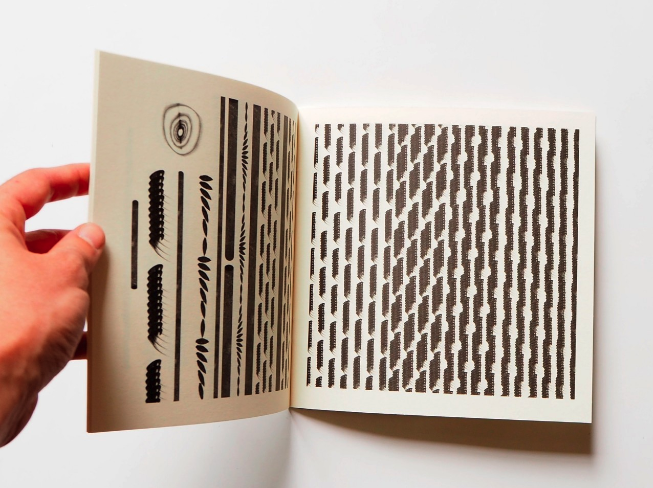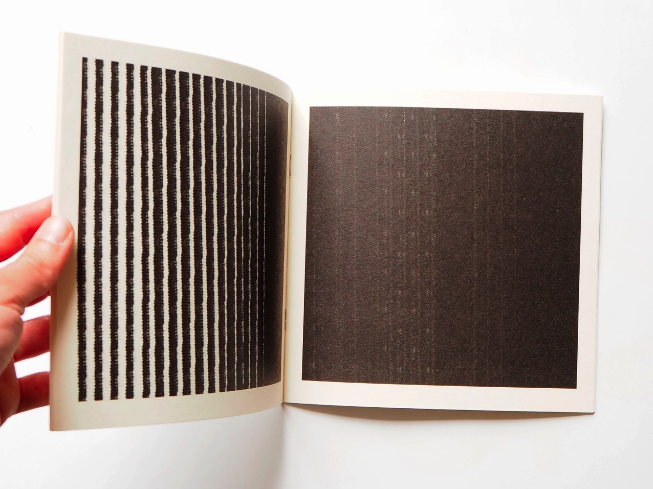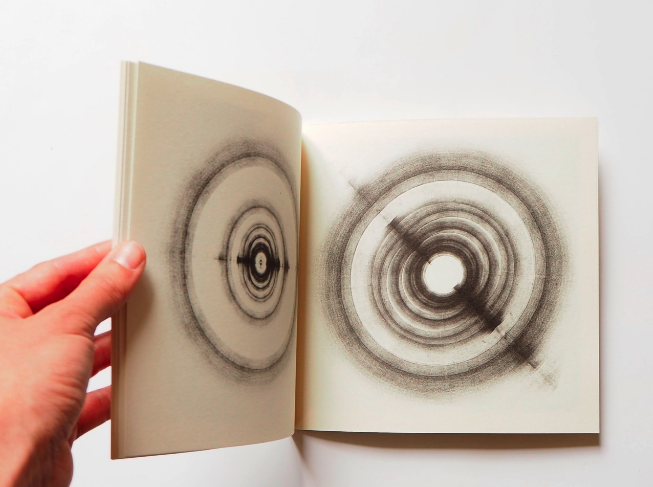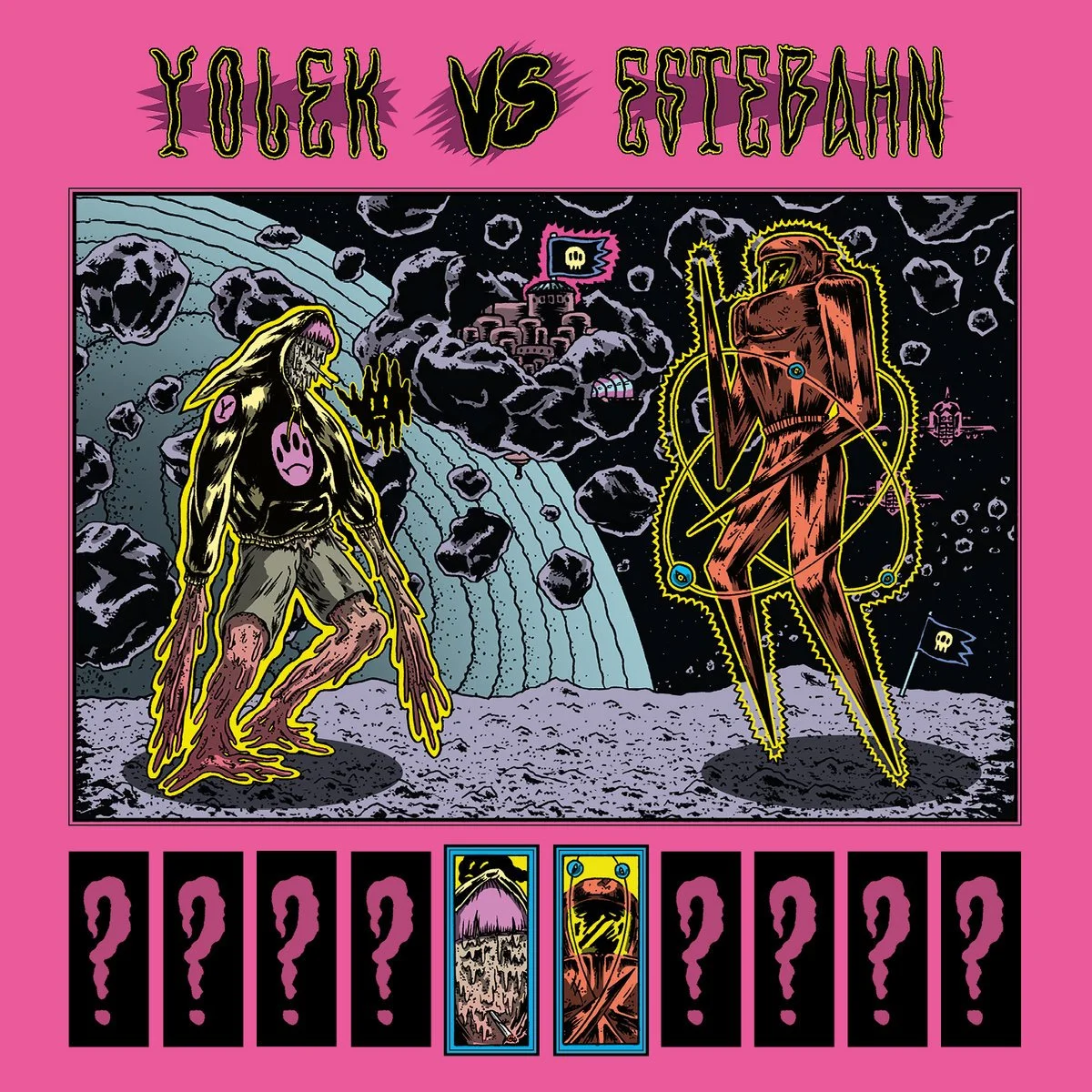Doing more with less: impacting with reduced complexity.
A chat with Thomas Perrodin.
Taking a step back from themes of self indulgence, greed and condemnation, the timing that I had with today's featured guest could not have landed at a better moment. An initial outsider who built his reputation by not wanting to take, but rather borrow and give back to his immediate surroundings.
Graphic designer and illustrator Thomas Perrodin is a person whose name reoccurs on the Geneva alternative scene, particularly in the field of music events. Seeing his works throughout the streets, Thomas explores various creative routes and himself, would rather talk about technique rather than his style. Talking to friends of his from the Genevan scene, it seems that the recurring thought that is shared amongst his admirers is that his art connects. They establish a memory of a time, at a place, surrounded by music and people, which are enthused amongst hundreds in the small, yet prolific Genevan scene. To some and others, he is not the sound but the faceless person who's name gives identity to the nights that echo across the lake Leman, archived in mischievous coloured-like prints.
Thomas gives himself even further by lending his knowledge to others by teaching illustration at the Geneva School of Comics and Illustration (ESBDI) since 2018. Additionally, he is also a publisher within the Hécatombe artists' collective and the author of magnificent contemplative object-books nourished by abstraction, screen-printed by his care in very limited edition.
In this chat titled “Doing more with less: impacting with reduced complexity”, we talk about assessing visual identity to music genres, making graphic partitions engraved onto flexi-discs, pedagogical methods of teaching for screen printing & illustration and sharing a similar childhood upbringing when it comes to correlating electronic music to video games.
So tell me a bit about how you came to who you are today?
I grew up in France, including a good part of my life in Paris. I studied fine arts in Angoulême to then come to Geneva to absorb new media. After finishing high school, I was doing odd jobs left and right where eventually I met people doing graffiti, so I did a bit with this. There are lots of interesting notions on the idea of the format with the graffiti, particularly the fact that there is not really a predefined format since it depends on the wall. That, and then lots of notions of typography surrounding graffiti, which made me more inquisitive in deepthening my knowledge within it.
When I arrived in Geneva I started with this new media course which was not really stimulating at the level of practice, where I found myself VJing a lot which is more of a decorative discipline for me. In the meantime, I had already approached this printing technique called screen printing and I had always been interested in graphic design. After a while of attending various local gigs and events, I wanted to find a way in how I can contribute to this alternative scene, so I started designing and producing flyers or posters. It did not matter if there was money or not. It's still a work dynamic I maintain today. The majority of my physical labour when it comes to my work is actually not where I make most of my money. Of course, with the quantity of projects that I do, it amounts to something, but money is certainly not the driving factor for my creative endeavours. I support myself financially with an accumulation of all these small job offers. Additionally, I am also a part time lecturer where I instruct the theoretical and physical approach to screen printing, as well as illustration concepts, contextualised to mandates for example.
And so how did you land in Geneva and get affiliated with L’Usine?
It was pretty coincidental. I didn’t really like the intellectual/academic system in France. It was pretty literal whereas I was looking for something more directing in leftfield approaches in education. I got the opportunity to study in Geneva and had some relatives living not very far from the border, so I figured this was a sensible direction to pursue. I did this for 2-3 months because the housing situation in Geneva is messed up. One day while I was hitchhiking, I got brought to this collective house called Clos Voltaire which housed about forty people. It was pretty chaotic but there was some people from L’Usine that were residents, so through this environment is how I got affiliated in the alternative/underground Geneva scene. I was not familiar with any scene like this beforehand because the squat scene can be perceived in a more negative light, at least in France, such as junkies shooting up on dirty mattresses. In Switzerland, it’s more of a community with shared values, that maintain the building and bring something to it. Although I was not part of any scene like this beforehand, I definitely shared the same spirit, which made it easier for me to transition into it.
In an online description of yourself, there is the use of the words empirical and experimental when describing your approach. Can you elaborate on how your work incorporates these two descriptions?
I was for a long time involved with digital textile printing, but because I was spending so much time behind the computer, I was in need of something more tangible to express myself artistically. Therefore screen printing seemed like an evident course of action. When I started doing posters for venues like La Cave 12, they always had eclectic bookings. It went in all directions and therefore it was too my advantage to incorporate it in my work. What I mean is that for example, with Black Metal, the typeface is very specific, a sort of unreadable typo that resembles a messed up graffiti. Not necessarily related to typography, Punk music might have something more aggressive and loud, such as a skulls with flames coming out of it with rats wearing flag armbands etc.. Where it gets experimental in my approach is that I break the rules between these genres and elements, by making perhaps a very narrow and loud yet rigid typography for the former genre, and then use a typography of similar sorts for the latter.
I have a premeditated intention, but my way of working is entirely analogue. I never use the computer for my screen printing practice. So basically, by thinking a little about the image I would like to make, it becomes a bit of investigative work that leads to being pushed more towards illustration work than graphics in order to decline graphic charters. Obviously, I have stylistic recurrences since after all, what I do is illustration but in the noble sense of the term. I do investigations on the graphic universes of the artists (who are playing that evening), biographies, reader over interviews they had and of course, listen to their music. From there is where it becomes empirical. I have my intention, start working in the studio and then as the project develops, I'm simply executing. After a while it becomes self-reflexive. At the same time, I am always asking myself the question as to why I proceed with a certain manner as well as to reflect everything I do during my procedure. For me, that's what makes my rendering empirical, I really let myself be carried away by my feelings during the development of the poster. I'm not into business models where people ask me to do research for something specific. The people I work with trust me with the performance briefing of that night and ultimately give me ‘carte blanche’, which is very important for my creative process. All these elements will allow me to incorporate them on what I have previously done in order to come out with something experimental. That said, I usually don't do a poster for the fact that it's a "headliner". I want to keep this horizontal in terms of the visual rush of visual synthesis of what I'm doing.
Regarding your art then, how would you describe it to someone who is unfamiliar with it?
Well I think it relates to before. I am influenced by a lot of things and try to incorporate them as much as possible in my work. It at times relates to various punk aesthetics or perhaps at times neo-psychedelic. I try to be as curious as possible and am always open. Stylistically, I find it has a bit of a schizophrenic vibe. To elaborate, it kind of depends on these various mandate offers because that’s how my style develops. My style feeds off what is proposed to me, so to speak. It’s a difficult question because it’s better for me to explain my technique as opposed to my style. It’s a very DIY approach after all and I keep my prints in very small quantities. This is due to space issues as well as me preventing my art from being mass produced. I rather have small prints (quantity wise) that I give out or sell in modeste amounts, than have an Instagram account where I am constantly selling prints in the form of a webshop.
I think I read that you arrived in Switzerland at the transitional period of the “Golden Age” of the Genevan squat scene, do you find that your style evolved and adapted to this transition or perhaps your artistic vision ?
I would say not because I came to Geneva in 2007, meaning right at the closure of Le Rhino and La Tour. Of course you are always influenced by your surroundings, but in my case, I would say that being exposed to this alternative environment has been more reflective in how I work.
“My values and ethics have been developed by living in shared quarters and communal living which then got reflected more in my manner of working.
For the sake of contributing (artistically speaking) to your local scene and making it accessible for all to use.”
Wanting to collaborate with people not always for the money, but for the project.
Otherwise I find, or think, that one’s stylistic approach is always developing. It has too. Life presents you with events, situations, surroundings… you know, living your life. Comparably the same way your speech, music taste, changes throughout the years.
I saw that you were part of a creative collective called Hécatombe, can you tell me more about that?
Of course. The Hécatombe is a collective founded in 2004, which interests itself more in the narrative aspect of illustration such as comic books. They got in touch with me around the time I arrived in Geneva for some collaboration work regarding fanzines. Since there were areas in screen printing that I wanted to explore, I thought this was a nice opportunity to seize. I published my first book through Hécatombe, which consisted of twenty units with screen printed works that I experimented with.
Hécatombe is a publishing company but not in the professional sense perhaps. What I mean is that there are no salaries. Everything is auto-financed, whether by us or cultural funding associations in Geneva or Switzerland, to which we make prints of various scales. Depending the project, it can go between 20 to 1000 copies. We explore different stylings in the form of series. For example in the beginning of 2010, there was an initiative to do a series that corresponds more to an art book, an object if you will. But these series always relate to the concept of the fanzine, to preserve that DIY ethos. We like to remain flexible in what we produce. Yannis (one of the founders) wants to launch a series of digital comic books. Not like webtunes or online manga, but something that relates more closely to ‘Band-Dessinées’. This was done to explore a different narrative style, so he wanted to use that approach to translate this into such a format. Actually, speaking of exploring different ways of narration through ‘Bandes-Dessinés’, I did a book titled “105 Livres Uniques“ published through Hécatombe where it was a progression in steps of screen printing techniques, a degradation of colours presented layers by layers, page by page, as a means to communicate the time spent and process when doing serigraphie. Yannis told me at the time in a jovial manner that it would be interesting to feature it in a comic book related contest, as it could be regarded as an unorthodox way of storytelling and could be presented as an experimental, narrative type within the ‘Bandes-Déssinés’ field.
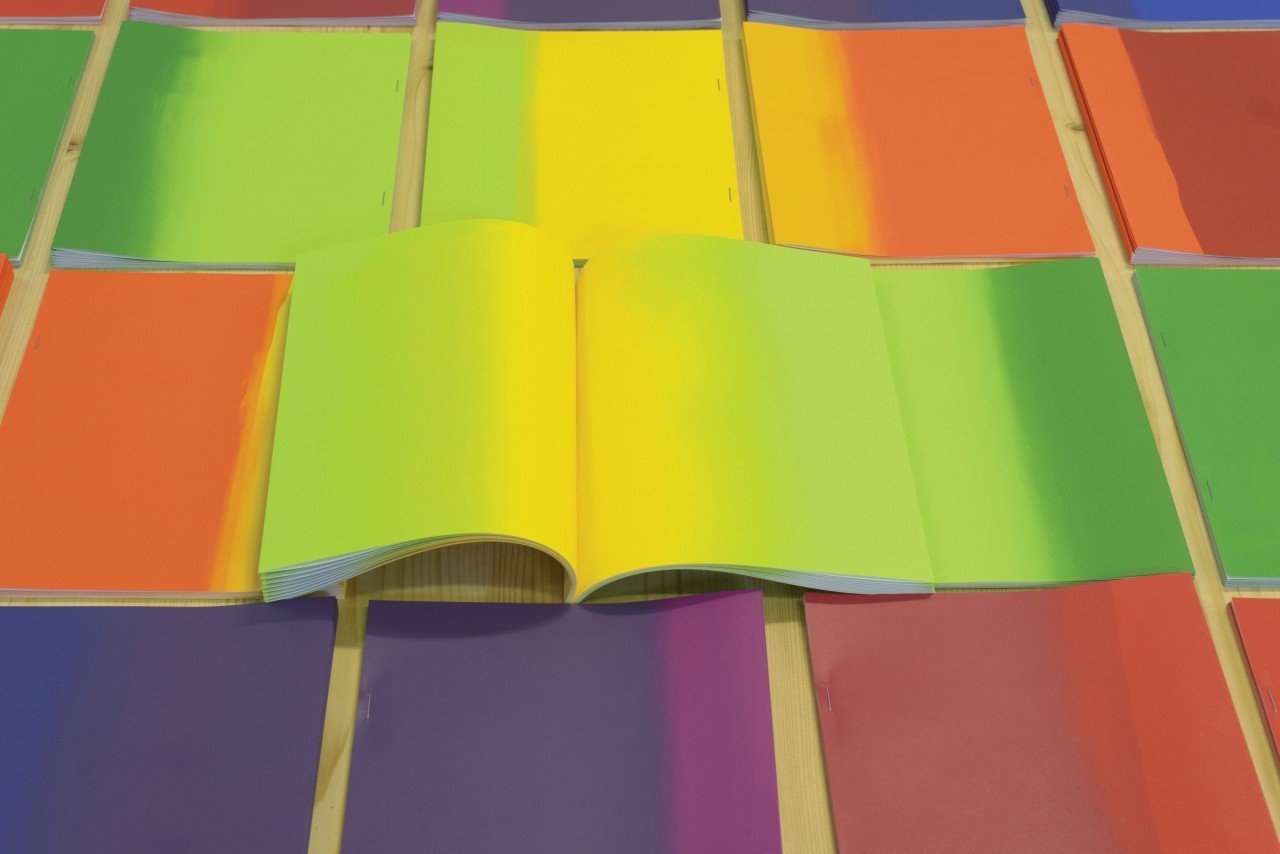
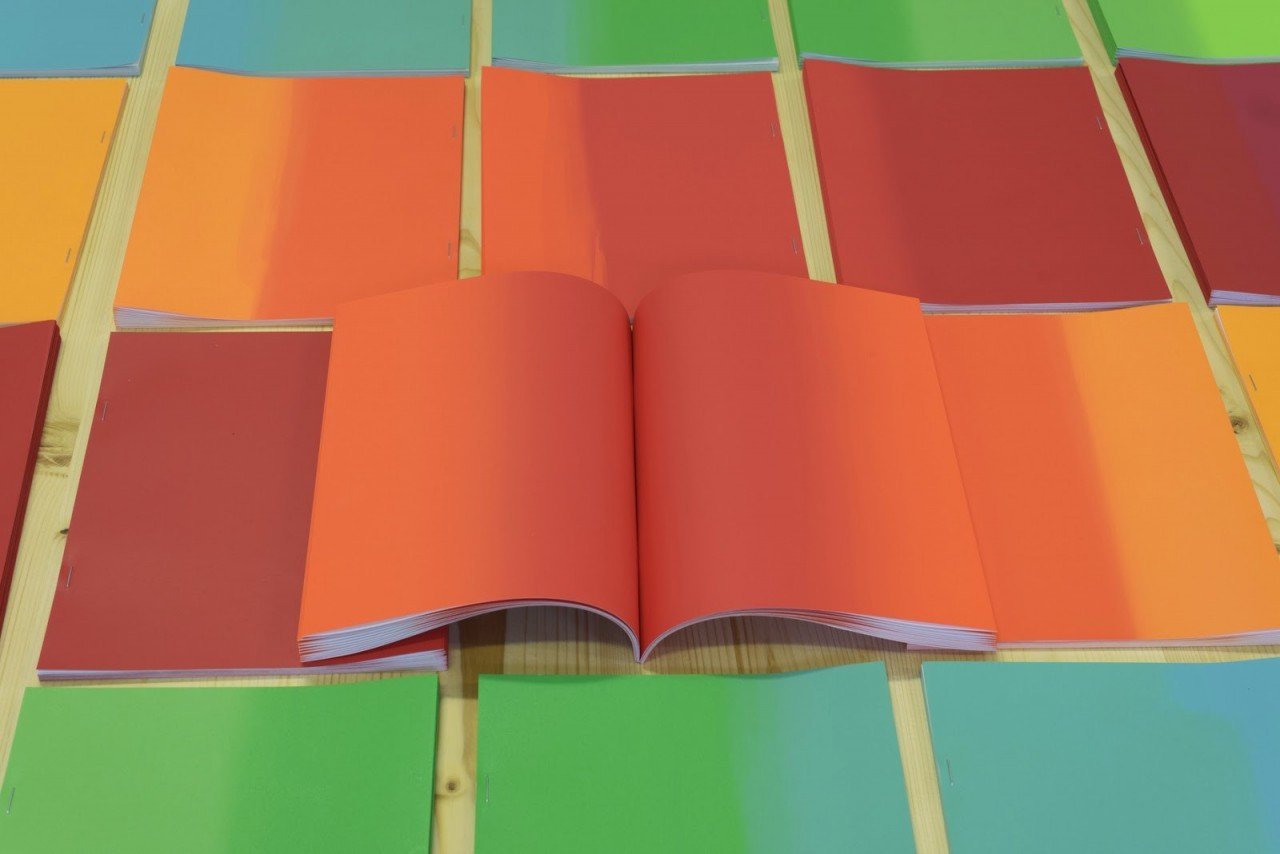
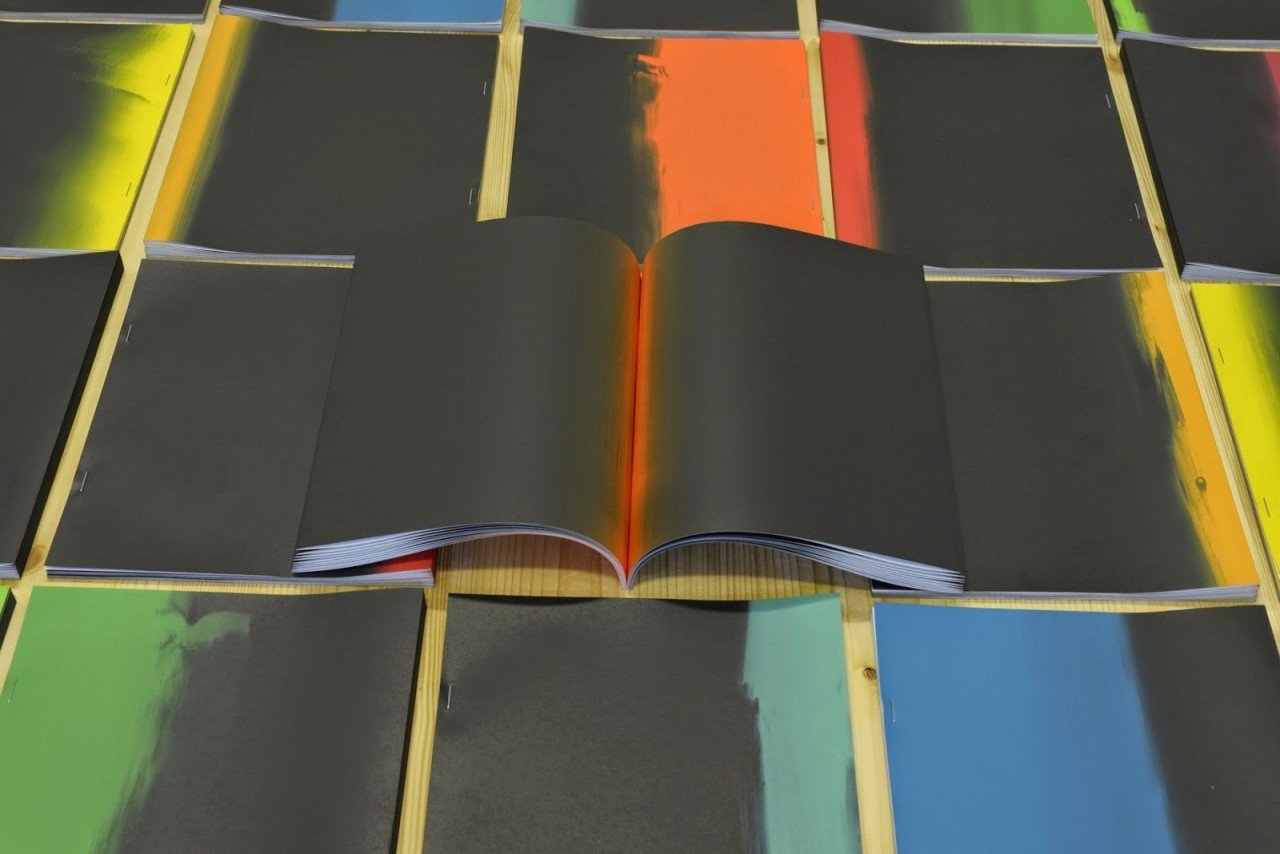
One of my favourite projects that you guys did through Hécatombe was the series Oblikvaj (Oblique in Esperanto) in 2019. How did this come to be?
It’s a project that Aude (from Hécatombe) piloted for about three years prior. Since we are interested in abstract approaches to the ‘Bande-Déssinés’ concept, we wanted to work with the Ensemble Batida to provide sound to this project. Aude has worked with Alexandra Bélon from the Ensemble Batilda beforehand and wanted to collaborate in further creative endeavours, so the starting point was from there. Since Hécatombe and the Ensemble Batilda had five members respectively, it felt perfectly appropriate to do this project divided into five instalments. The genesis of Oblikvaj came from our interest to do graphic partitions, therefore the Ensemble Batidla needed to make a composition per instalment, with or without artistic direction. In support of this project, there was a little tour where we sold those flexi-discs with graphic partitions. Eventually, a "collector's" work will be produced and will bring together all the scores in a beautiful book, accompanied by a triple-vinyl containing all the recordings of the series. It was a fantastic project because a lot of questions came out of it. There’s a graphic language, sort of universal, to write and read music (at least in an occidental fashion), and it was very interesting to ask yourself how far can you take it, is there a point to recreate a musical language, or is it good to keep it as an own project.
Going back to what you said earlier, you said you need screen-printing in your life as it is a discipline that allows you to express yourself more, as a means to apply physical labour, experiment through trial and error whilst having technical limitations. Does your approach to a project differ, say, when you make a poster in an analog as opposed to digital approach?
Not at all. If I am screen printing, I need to plan in advance in my head what my options are before diving into it. I need to think what printing techniques I’d like to apply, the limitations in colour that I can achieve for its end result and what kind of rendering I want the artwork to be presented as. As you know, in the digital realm, there are literally infinite possibilities in which you can attain the desired end result. It’s not to diminish or favour one practice over the other, but with physical screen printing, there are obvious limitations. With such limitations (for instance, just using two colours), you really investigate and try to leave no stone left unturned to see how far you can take this creative endeavour, which obviously can produce ‘happy accidents’ at times and thus, more areas for investigation. It depends on the project or mandate though. Something digital, I could do through screen printing, but not the other way around. Having this challenge at hand is really beneficial for my process of bettering myself as an artist and so I rely on making things ‘complicated’ in that sense for me.
I noticed that you were a teacher for pretty much the past decade. Whether being a lecturer for the HEAD or more currently, at CFPARTS - ESBDI. I mention this because you described your artistic approach as being experimental as well as creating with the mindset of trial and error in order to find your own creative voice. As a teacher, you are sometimes restricted with guidelines of a cursus, therefore how do you transfer such a philosophy to your students within the academic context?
My more recent academic related work does not revolve around the traditional academic premise. I design my own courses with exercises that I find relevant for my students. What we really try to transfer to our students is self-publishing, how to be autonomous and to continuously develop one’s self. Perhaps an example you can relate to better is from the perspective of a musician, say a beat maker or producer. You shouldn’t wait for high hopes and dreams of a record label magically finding you to release your work. Just release it yourself. Going back to my case, of course you can send your work to a publisher, get your art printed in a book and 6 months later hope for the best, but we really want to communicate the process to our students for them to know how to do this and having the understanding of the process so that they can do it themselves.
Besides that DIY approach of learning as well as providing students with a screen-printing atelier, I bring my students a lot of books, ranging from photography to “Bande-Déssinés”. Since most of the newer generation experiences things digitally, I find it important to make my students aware of tangible art, of its end result, and to hopefully get them inspired in generating new ideas that will make them think out of the box. This is particularly important and relevant since I specialise in illustration of order relating to “Bande-Déssinés”. To add to this, it relates somewhat to what I said earlier relating to the music industry. Of course you have access to most music digitally. However, when using the concept of vinyl for example, playing a LP means engage with the music differently than you would by blatantly listening to a Spotify playlist, which also let alone may not hold the same conceptual format as an album. It is reciprocal in relation to what I said regarding visual art. t’s important for me to make my students understand the nuances and intricacies that make each artform unique and attractive in their own respective way.
[...] I have a really big fascination with video games. When I was a kid, I was exposed to N64 and PS1 era games, where I would play them endlessly. I would enjoy the graphics, storytelling and especially the soundtracks. I would find myself sometimes just sitting in front of the menu/title screen of a game, and just let this loop play endlessly as I sat there in awe. Today, I realised that this subconsciously played a big role in my love for electronic music. Looking at your work, when it comes to making posters for electronic acts or events, I feel that there is quite the resemblance to either covers and artwork of the aforementioned period of early mainstream domestic game consoles, specifically at times emitting nods to 1v1 style fighting games. My question being: did you share a similar childhood regarding video games and therefore share a similar perspective when it comes to their relation to electronic music?
Yes, absolutely. I am a bit older than you so I really got to see the progression and development of video games throughout the years. I was exposed to the SNES, the Amiga 500 that was borrowed from my uncle, which had some of the craziest sounds and soundtracks, and a friend of mine who had the PS1 which we spent countless hours on games such as “Wipeout”. I mean, the whole package of a video game at the time, such as the game and its soundtrack, the booklet that came with narrations and explanations of the game, company logos and of course, the artwork for the boxset with graphics that explode to your face (metaphorically speaking), the whole product as the video game was an experience that included the visual, touch and hearing side of sensory experiences, which was, and still very impressionable on me.
To this day, I still play video games, when I have time anyways. It’s a great source of inspiration for me because it features universes where the artwork and graphics are tremendously rich in content. Even indie games, which I don't necessarily play, I try to stay up to date as a means of inspiration. Since the technology is constantly evolving, you get new types of artwork and pixel art when it comes to the visuals regarding the game’s world and character design, whilst not neglecting the quality of music. I’m not too interested in hyper realistic, 3D video games, although I appreciate and recognise the beauty they hold on their own. I’m more into those obscure, silly, weird Japanese video games that exploit such nostalgic vibes. The amount of emotion you can get through 8-bit music is perhaps a bit silly, but it proves my point of doing more with less, and simplicity can have much more of an impact on a life than something overdone and complex.

